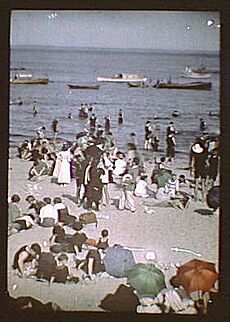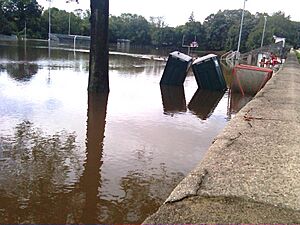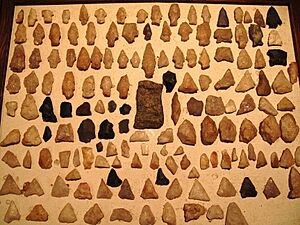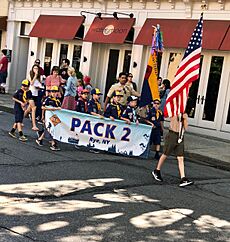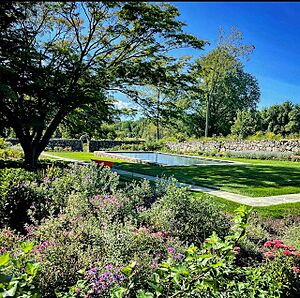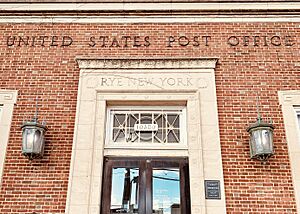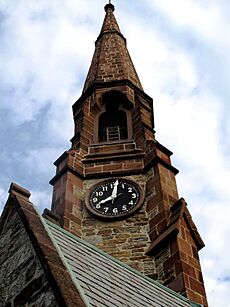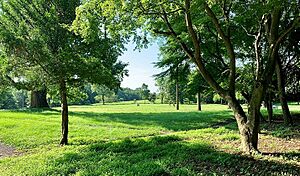Rye, New York facts for kids
Quick facts for kids
Rye, New York
|
||
|---|---|---|
| City of Rye | ||
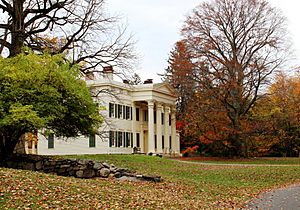
Jay Estate is the childhood home of American Founding Father John Jay.
|
||
|
||
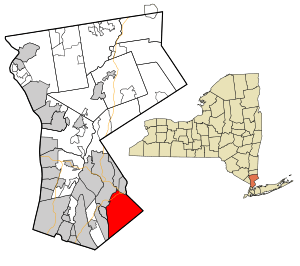
Location in Westchester County and the state of New York
|
||
| Country | ||
| State | ||
| County | Westchester | |
| Incorporated (as a village) | 1904 | |
| Reincorporated (as a city) | 1942 | |
| Government | ||
| • Type | Council-Manager | |
| Area | ||
| • Total | 20.02 sq mi (51.86 km2) | |
| • Land | 5.85 sq mi (15.16 km2) | |
| • Water | 14.17 sq mi (36.70 km2) | |
| Population
(2020)
|
||
| • Total | 16,592 | |
| • Density | 2,834.79/sq mi (1,094.60/km2) | |
| Time zone | UTC−05:00 (EST) | |
| • Summer (DST) | UTC−04:00 (EDT) | |
| ZIP Code |
10580
|
|
| Area code(s) | 914 | |
| FIPS code | 36-64309 | |
| Website | http://www.ryeny.gov/ | |
Rye is a city located right on the coast in Westchester County, New York. It's close to New York City. Rye is different from the larger Town of Rye.
The City of Rye used to be a village. It became a city in 1942, making it the newest city in New York State. About 60 percent of Rye's land is waterfront, which means it's right by the water. The city has special rules to protect its waterfront areas.
Rye is home to two important places called National Historic Landmarks. One is the Boston Post Road Historic District. It's the only one of its kind in Westchester County. A key part of this district is the Jay Estate. This was the childhood home of John Jay, one of America's Founding Fathers and the very first Chief Justice of the United States.
Another famous landmark in Rye is Playland. This historic amusement park became a National Historic Landmark in 1987. Playland has one of the oldest wooden roller coasters in the Northeast, called the Dragon Coaster.
Contents
A Look at Rye's Past
Rye was once part of Fairfield County, Connecticut. It was founded in 1660 by three men: Thomas Studwell, Peter Disbrow, and John Coe.
In the 1800s and early 1900s, Rye was a popular getaway. Wealthy people from Manhattan would travel there by coach or boat to escape the summer heat. Its location on Long Island Sound and its many beaches also attracted other visitors. They would stay in cottages and hotels by the water.
Rye has many old and beautiful buildings. These buildings help show the unique history of its different neighborhoods.
Understanding Rye's Geography
According to the United States Census Bureau, Rye covers about 20 square miles. About 5.9 square miles are land, and 14.2 square miles are water.
Rye is located in the eastern part of Westchester County, right on Long Island Sound. The western edge of the city follows Beaver Swamp Brook. Milton Harbor and the Sound form the eastern border. Blind Brook flows through the city, from the northwest to Milton Harbor in the south.
Rocks, Marshes, and Wetlands
Rye's landscape has a lot of rocks, marshes, and wetlands. This makes the city very beautiful but also tricky for building new things.
The ground in Rye is mostly made of Fordham gneiss and Harrison diorite. These are types of rock.
Rye has many important natural areas, especially near the water and brooks. The Milton Harbor area, Disbrow Park, and the Manursing area have the largest wetlands. Many areas near the Sound and brooks are also in flood zones. This means they can flood easily.
To protect these areas, Rye has rules to prevent damage to wetlands and waterways. The city tries to make sure that any activities that might harm these natural systems are done in other areas.
Flooding Challenges in Rye
Flooding has been a problem in Rye for a long time. Water comes in from Long Island Sound. The Blind Brook watershed also causes flooding. Heavy rains in October 1975 caused significant floods in the Indian Village neighborhood.
Three big storms in just five years caused a lot of damage in Rye:
- In March 2007, there was major flooding. Six weeks later, the April 2007 nor'easter caused some homes to have over five feet of water.
- In 2011, Hurricane Irene and Hurricane Maria caused Blind Brook to overflow. This flooded homes and businesses, including the Rye Nature Center and the Rye High football field.
- In 2012, Hurricane Sandy caused storm surges. Many homes and buildings near the coast had to be evacuated.
To deal with these floods, Rye got $3,000,000 from a state program. This money helps the city protect itself from future floods. It also helps improve its infrastructure and protect historic buildings and wetlands.
On September 1, 2021, Rye had another big flood. The storm lasted two days and caused a lot of damage. Areas that had flooded during Hurricane Irene were under 8–9 feet of water. This happened after Hurricane Henri brought about five inches of rain. Two weeks later, Hurricane Ida dropped another 8–9 inches of rain in just 12 hours.
Important Archaeological Sites
As of 2010, about 75% of Rye's land has been found to be archaeologically sensitive. This means there are many sites where Native Americans lived or visited. It is believed that at least two villages existed, one on Manursing Island and another on what is now Milton Point.
Evidence of Native American activity has been found in many places. Tools and bones have been unearthed. An "ancient Indian burial ground" was found where the Playland Casino is today. Artifacts, pottery, and skeletons have also been found along the shoreline and in areas like Disbrow Park.
More recently, a 2012 study found a dozen archaeologically sensitive areas near the Playland Parkway. This study found shell mounds, old campsites, and at least two burial grounds. One of these sites was near Blind Brook.
Rye's Unique Neighborhoods
Many of Rye's neighborhoods are special. They have historical importance, and keeping them as they are helps Rye keep its unique character. Some of these neighborhoods include:
Proposed National Register District
- Soundview Park
- Church Row
Local or National Register Significance
- Dogwood/Upper Dogwood Lane
- Grace Church Street Area
- Milton Harbor
- Kirby Mill
- Post Road Old Cottage District
- Central Business District
- Dublin (West Rye)
- Greenhaven
- Indian Village
- Loudon Woods
- Rye Town Park
- Hix Park
Rye's Population
| Historical population | |||
|---|---|---|---|
| Census | Pop. | %± | |
| 1910 | 3,964 | — | |
| 1920 | 5,308 | 33.9% | |
| 1930 | 8,712 | 64.1% | |
| 1940 | 9,865 | 13.2% | |
| 1950 | 11,721 | 18.8% | |
| 1960 | 14,225 | 21.4% | |
| 1970 | 15,869 | 11.6% | |
| 1980 | 15,083 | −5.0% | |
| 1990 | 14,936 | −1.0% | |
| 2000 | 14,955 | 0.1% | |
| 2010 | 15,720 | 5.1% | |
| 2020 | 16,592 | 5.5% | |
| U.S. Decennial Census | |||
In 2020, there were 16,592 people living in Rye. This means there were about 5,491 households. Most adults in Rye (74.8%) have a college degree. About 15.5% of the population was over 65 years old, and 51.7% were women.
Economy and Businesses in Rye
Rye is home to several companies, including:
- Con Edison
- Jarden
- GAMCO Investors
- Sims Metal Management
Arts, Culture, and Events
Learning and Entertainment
Rye offers many places for learning and fun:
- Jay Heritage Center
- Rye Arts Center
- Rye Free Reading Room
- Rye Historical Society
- Wainwright House (built in 1928) is a historic estate with gardens. It was later used as a spiritual and educational center.
Fun Community Events
Rye has several big community events each year:
- Rye Little League Parade (April)
- American Legion Memorial Day Parade (May)
- Rye Sidewalk Sale (July)
- Jay Day (September)
- Rye Harrison Football Game (October)
- Rye Window Painting (October)
- Rye Turkey Trot (November)
- Mistletoe Magic (December)
Important Historic Sites
Rye has two of the more than 2,600 National Historic Landmark (NHL) sites in the United States. These are the Boston Post Road Historic District and Playland Amusement Park. Both are also listed on the National Register of Historic Places.
Rye also has one of the few National Historic Landmark Districts in the country.
Boston Post Road Historic District
The Boston Post Road Historic District includes five important historical areas. Much of this land was originally owned by John Jay, one of America's Founding Fathers. He grew up here and is buried here.
- Jay Estate – This is a 23-acre park with gardens. The Jay Heritage Center manages it. The Jay Mansion (built in 1838) overlooks Long Island Sound. It was restored as part of the Save America's Treasures Program. The Jay Mansion is the oldest National Historic Landmark building in New York State with a geothermal heating and cooling system. It's also part of Westchester County's African American Heritage Trail. Other old buildings on the estate include a 1760s farmhouse and a 1917 Tennis House.
- Lounsbury (1836–38)
- Marshlands Conservancy (part of the original Jay Estate)
- Whitby Castle (Rye Golf Club) (1852–54)
- The Jay Cemetery (started in 1805)
Playland Amusement Park
Rye Playland is a 279-acre theme park. Westchester County owns and runs it. The park has rides, games, an indoor skating rink, a beach, and a boardwalk. It's one of only two amusement parks in the country with National Historic Landmark status. The other is Kennywood in Pennsylvania. Playland has been a popular place since it opened in 1928.
Its wooden roller coaster, the Dragon Coaster, was built in 1929. It's one of the last roller coasters built by engineer Frederick Church that is still running. The Derby Racer, also built by Church, is one of only three like it left in the world. Playland was also used as a setting for scenes in the 1988 movie Big, starring Tom Hanks.
Other National Register Historic Sites
Rye has 10 sites listed on the National Register of Historic Places (NRHP). This includes Playland and the Boston Post Road Historic District.
- Bird Homestead, (listed 2010)
- Boston Post Road Historic District (listed 1982)
- Timothy Knapp House, (listed 1982) This is the oldest house in the city, built around 1667. It's owned by the Rye Historical Society.
- Milton Cemetery (listed 1982)
- Playland (listed 1980)
- The Square House (listed 1974) This inn was built in 1730. George Washington stayed here twice and wrote good things about it in his diaries.
- Rye African-American Cemetery, (listed 2003)
- Rye Meeting House, (listed 2011)
- Rye Town Park-Bathing Complex and Oakland Beach, (listed 2003)
- United States Post Office – Rye, (listed 1989)
Local Landmarks
Rye has a law to protect certain properties as local landmarks:
- Haines-Robinson House (1867)
- Jay Estate
- Stillman Residence (1915)
- Village Green
More Historic Resources
You can find two milestones (markers) on the Boston Post Road that are over 200 years old. These markers show the distance from New York City. Benjamin Franklin started the idea of mile markers in 1763.
Rye also has a special mural from 1938 by artist Guy Pene du Bois. It's in the city's Post Office lobby and is called John Jay at His Home.
Two of the 16 sites on the African American Heritage Trail of Westchester County are in Rye: The Rye African-American Cemetery and the Jay Estate.
Cemeteries and Burial Grounds
Rye has several cemeteries and burial grounds:
- Greenwood Union Cemetery – started in 1837
- Guion Cemetery
- Milton Cemetery – oldest burial recorded in 1708
- Rye African-American Cemetery – started in 1860
- St. Mary's Cemetery – earliest burial in 1854
- Playland Ice Casino – site of a Native American burying ground
Churches and Synagogues
- Christ's Church (Episcopal) – started in 1695
- Church of the Resurrection
- Community Synagogue of Rye
- Congregation Emanu-El of Westchester
- Rye Presbyterian Church (1870)
Parks and Recreation in Rye
Rye has over 454 acres of green open space. People can use these areas for walking, hiking, bird-watching, and dog walking. Rye is also a coastal community, so it has special rules to protect its water areas.
Parks and Nature Reserves
- Edith G. Read Wildlife Sanctuary (179 acres) – started in 1985.
- Jay Estate (23 acres) – opened as a park in 1992. Dogs on leash are allowed.
- Marshlands Conservancy (137 acres) – opened as a nature preserve in 1966. No dogs allowed.
- Rye Nature Center (47 acres) – opened in 1957.
- Rye Nursery Park (6.74 acres) – used for wetland restoration and park activities.
- Rye Town Park (62 acres) – opened in 1909. It's shared with the Town of Rye. Dogs are allowed during certain hours.
Private and Public Clubs
Rye has many private clubs, some started in the late 1800s and early 1900s. These clubs offer over 993 acres for recreation.
- American Yacht Club (New York) (started 1883) – for sailing, tennis, paddle.
- The Apawamis Club (1890) – for golf, squash, tennis, paddle, swimming.
- The Coveleigh Club (1933) – for tennis, swimming, beach, bocce.
- Manursing Island Club (1912) – for tennis, swimming, beach.
- Rye Golf Club (1921) – for golf, swimming.
- Shenorock Shore Club (1945) – for tennis, swimming, beach.
- Westchester Country Club (1922) – for golf, tennis, squash, paddle, swimming, beach.
Recreation Facilities
Rye has many public and private sports facilities for activities like tennis, ice hockey, and boating.
City-Owned Recreation Facilities (79 acres total)
- Damiano Recreation Center (1.5 acres)
- Disbrow Park (51 acres) – has 4 tennis courts and baseball fields.
- Gagliardo Park (2.5 acres)
- Rye Nursery Park – has natural grass fields for soccer and lacrosse.
- Rye Recreation Park (17 acres) – has tennis courts and soccer fields.
Other City-Owned Facilities
- Rye Boat Basin/Marina – for boating.
- Rye Golf Club (126 acres) – for golf and swimming.
- Rye High School – for football, tennis, track. Their teams are called the Garnets.
- Osborn School
- Midland School
- Milton School
Other Recreation Facilities (Not City-Owned)
- Playland Ice Casino – for skating and hockey.
- Row America Rye – for rowing.
- Rye Country Day School – for skating and hockey. Their teams are called the Wildcats.
- Rye YMCA – for swimming and fitness.
- School of the Holy Child (18 acres)
- Tide Mill Yacht Basin
Education in Rye
Public Schools
Most of Rye is part of the Rye City School District. There are three public elementary schools: Osborn, Milton, and Midland.
Rye Middle School and Rye High School are on the same campus and are connected.
Some neighborhoods in Rye are served by the Rye Neck School District. Rye Neck High School and Middle School are also on one campus, partly in Rye.
Rye High School was named a Gold Medal school. It was ranked as the 61st-best high school in the U.S. and ninth-best in New York state by U.S. News & World Report in 2013. The annual Rye-Harrison football game is a big rivalry in Westchester County. Rye High School's mascot is the "Garnets" because many of these gems were found when the school was built.
Rye schools were recently ranked #18 in New York State.
Private Schools
- Rye Country Day School, for Pre-K through 12th grade.
- Resurrection Elementary School is a Catholic school in Rye.
Media in Rye
- MyRye.com
- The Rye Record – a community newspaper started in 1997.
- Rye TV – local cable programming from the city.
City Services and Transportation
Transportation
The Rye train station offers train service to Grand Central Terminal in New York City. You can also go to Stamford and New Haven using the Metro-North Railroad's New Haven Line. The Bee-Line Bus System also serves Rye with routes 13 and 61. There's extra bus service to Rye Playland during certain seasons.
Police Department
The Rye Police Department has 36 police officers. The Rye Auxiliary Police is a group of volunteers who help when needed. The Westchester County Police also patrol parts of Rye.
Fire Department
The Rye Fire Department has 100 volunteer firefighters and 21 paid firefighters. They have two fire stations.
Emergency Medical Services
Emergency medical services are provided by Port Chester-Rye-Rye Brook EMS. They have 30 paid EMTs, 15 paramedics, and five volunteers. They operate ambulances and respond to over 5,000 calls each year in Port Chester, Rye, and Rye Brook.
Famous People from Rye
- Christopher Atkins, actor
- Jason Bateman, actor
- Justine Bateman, actress
- Barbara Bush, former First Lady, attended Milton Elementary School
- Doja Cat, rapper and singer
- Glenn Close, actress (mentioned in the Playland section)
- Tom Hanks, actor (mentioned in the Playland section)
- John Jay, Founding Father and first Chief Justice of the United States
- Megyn Kelly, TV journalist
- Ralph Kiner, professional baseball player
- Nick Kroll, actor, comedian
- Adam Silver, commissioner of the NBA
- Kimberly Williams, actress
- Bob Woodruff, ABC television journalist
|
See also
 In Spanish: Rye (Nueva York) para niños
In Spanish: Rye (Nueva York) para niños



